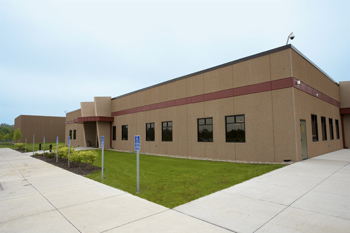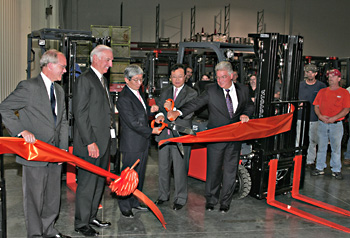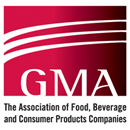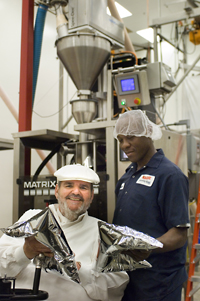
Hormel plant receives LEED Gold certificate
“We are very proud of the fact that Progressive Processing is LEED Gold certified, which sets a new standard for the food industry,” says Jeffrey M. Ettinger, chairman of the board, president and chief executive officer at Hormel Foods. “When we decided to open Progressive Processing, we saw an opportunity to build a state-of-the-art sustainable facility that aligns with our strong commitment to corporate responsibility.”
Progressive Processing will use at least 25 percent less energy and water than a plant built to meet current building codes and industry standards. The facility was also constructed using materials with more than 36 percent recycled content. Noteworthy elements of the sustainable design and construction include:
· A sustainable site, including non-irrigated landscaping that was developed with native, low-maintenance vegetation.
· Lighting controls that monitor the amount of light needed based on daylight, occupancy and time schedule. Similar monitoring is used for temperature control, using sensors to identify room occupancy and determine heating or cooling needs.
· Skylights and multilevel lighting that provide natural light and reduce energy consumption in non-refrigerated areas of the plant.
· Sophisticated heat and water recovery processes. For example, as part of the boiler system, heat from blowdown water is recovered, and the water is captured and reused for flushing toilets.
“Progressive Processing’s LEED certification demonstrates tremendous green building leadership,” says Rick Fedrizzi, president, chief executive officer and founding chair at U.S. Green Building Council. “Buildings are a prime example of how human systems integrate with natural systems. The Progressive Processing project efficiently uses our natural resources and makes an immediate, positive impact on our planet, which will tremendously benefit future generations to come.”
Progressive Processing opened in January 2010. The facility currently produces Hormel Compleats microwave meals plus Hormel and Valley Fresh chunk chicken. It spans 348,000 sq. ft. and will cost $89 million when complete.
Toyota celebrates 20th birthday with new lift truck
The facility has the capability to manufacture a wide range of industrial equipment including three- and four-wheel electric lift trucks; internal combustion, cushion-tire and pneumatic-tire lift trucks; diesel tow tractors and DC/AC inverter assemblies for the Toyota Tacoma.
In the pursuit of “kaizen,” or continuous improvement, TIEM has attained a number of industry recognitions/certifications including: operation as a zero landfill facility and receiving

McCormick's Wilson to keynote GMA's Manufacturing Excellence Conference
Manufacturing excellence in today’s food, beverage and consumer products companies is being driven by many factors including product safety, sustainability, globalization, consumer demands, technology and heightened competition for resources.
Automation News

Chef Paul Prudhomme's Magic Seasoning Blends consolidates manufacturing operations, installs automation
To meet the increasing demand for its products, Magic Seasoning Blends recently consolidated its two separate manufacturing and warehouse operations into one 125,000-sq.-ft. blending, packaging and warehouse facility. The company stocks 800 to 1,000 different spice ingredients, acquired direct from growers and distributors in various parts of the world. The ingredients are received by pallet loads of 50-pound boxes or 1,000-pound super sacks, coming from specific lot numbers in the growing fields to ensure uniform taste.
The plant environment is climate controlled to maintain consistent air temperature and humidity for the entire process of receiving, storing, blending and packaging. This minimizes product caking and streamlines throughput.
When a blend is released for production, ingredients are moved from the raw products warehouse to the plant’s blending area where they are placed into mixers located beneath loading stations equipped to handle up to 1,000-pound super sacks. Multiple horizontal double-ribbon blenders of various sizes make it possible to blend seasoning batches from 100 to 10,000 pounds; a typical batch is either 2,500 or 5,000 pounds.
After blending, the formulations are discharged into intermediate bulk containers (IBCs), capable of holding 2,500 pounds per sack. Then they are put into a climate-controlled warehouse until ready for packaging.
When an order is initiated for packaging, the selected IBCs are pulled from the warehouse and delivered to the automatic filler/unloader that feeds the filling machine designated for the run. The new plant has seven packaging lines:
- Bottling line for glass or plastic-Typical bottle size filled is 2 to 8 ounces for supermarket shelves and 24-ounce plastic jars for institutional use and restaurants. The system fills, caps and labels at the rate of 100 bottles per minute.
- Canning line-Used primarily for filling 8- to 16-ounce fiberboard canisters for retail sales, at the rate of 125 canisters per minute; it also fills 24-ounce canisters for foodservice and restaurants at 55 units per minute.
- Bag-in-box line-This line fills up to a 50-pound bag inserted into a box for institutional use and restaurants.
- Three flexible bag lines-Two horizontal form-fill-seal systems handle bag content sizes from 0.10 to 3.5 ounces; a vertical form-fill-seal line handles bags ranging in size from 4 ounces to 6 pounds.
- Cartoning line-Once packaged and labeled, the products pass through a cartoning line where they are automatically filled into boxes, sealed and labeled. A pick-and-place robot picks up and palletizes the boxes.
The pallets are stretched wrapped, then put into a climate-controlled warehouse or loaded into trailers for shipping.
“Twenty-five years ago, we were packaging everything by hand, screwing caps on by hand, labeling by hand, filling boxes by hand.” says David Hickey, vice president of manufacturing for Magic Seasoning Blends. “Now we are highly automated, and that has helped to bring an even higher level of consistency to our product line.”
To help maintain quality control, the entire facility is access-control secured. “Door card readers tie in with a comprehensive camera system to allow only authorized personnel into the facility,” Hickey explains, But we also use the camera system to keep our distributors and food processing clients informed about the location of their orders in the production, packaging and shipping process. Our co-packing clients, for example, can log onto our website and actually see their products in production.”
Despite the benefits of technology, Magic Seasoning Blends has not lost sight of it hands-on legacy. Since the day the company was formed, Chef Paul has been intimately involved in every aspect of its running.
“There is absolutely no end to developing herbs and spices,” says Chef Paul. “And my real passion is to make something that is healthy and exciting for our customers.”
For more information on Chef Paul Prudhomme’s Magic Seasoning Blends, Inc., contact John L. McBride, 504-732-3590; jlm@chefpaul.com or visit the website.
WirelessHART approved by the Europeans
The IEC Standard was approved by CENELEC as a European Standard without any modification. According to the announcement of approval issued by CENELEC, “members are bound to comply with the CEN/CENELEC Internal Regulations, which stipulate the conditions for giving this European Standard the status of a national standard without any alteration.”
“In March the WirelessHART specification was approved by the International Electrotechnical Commission as a full international standard (IEC 62591Ed. 1.0),” says Ron Helson, executive director of the HART Communication Foundation. “Approval as a European National Standard further confirms acceptance of the technology by users and suppliers as a technically sound, reliable and secure solution for wireless communication in process automation.”
A growing number of WirelessHART-compatible products are available today from major global suppliers including ABB, Emerson, Endress+Hauser, MACTek, Nivis, Phoenix Contact, Pepperl+Fuchs, Siemens and others.
Released in September 2007, WirelessHART is an open and interoperable wireless communication standard designed to address the critical needs of industry for reliable, robust and secure wireless communication in real-time industrial process measurement and control applications. For more information, visit the HART website.Food Safety News

How safe is Gulf seafood?
Environmental Attorney Stuart H. Smith (Smith Stag LLC) thinks more scrutiny is needed. “Independent water and seafood testing and analyses by Gulf Oil Disaster Recovery experts reveal that highly toxic chemicals remain in the water and food chain. These toxins pose a significant risk to marine reproduction and human consumption of Gulf seafood.”
Smith says FDA data shows it might not have taken samples in contaminated waters, and the Gulf area needs at least eight more months to recover. Smith represents the United Commercial Fishermen’s Association, the Louisiana Environmental Action Network, public and private entities, and citizens harmed by the BP oil catastrophe.
“The greatest concern is the presence of chemicals known as PAHs (or polynuclear aromatic hydrocarbons), which have carcinogenic properties. Our studies have shown that PAHs are present in shrimp from the impacted Gulf areas of the spill at 10 times the levels found in shrimp from inland, low-impacted areas,” says Smith.
In a page of definitions, the US Geological Survey says, “PAHs often are byproducts of petroleum processing or combustion. Many of these compounds are highly carcinogenic at relatively low levels.”
“BP’s use of dispersants at 5,000 feet below the sea surface caused PAHs and other toxic substances to remain in the seawater,” says Smith. “This means biodegradation of the toxins in crude oil is greatly reduced. It could be at least eight months before the toxic soup we are seeing in the Gulf experiences significant biodegradation, due to low temperatures, lack of sunlight and other factors,” he adds.
Dr. Samantha Joye, marine biologist and professor of marine sciences at the
“The impacts of the oil, gas and dispersant on the Gulf’s ecosystems will be felt for years, if not decades. We cannot pretend the danger has passed for it has not,” Joye warns.
Smith insists that hasty decisions to re-open commercial fishing in selected off-shore areas, which provides seafood to consumers in
Bad eggs since May
Working closely with CDC and state public health partners, FDA reviewed epidemiologic and environmental investigation documents and identified three best-case clusters of Salmonella Enteritidis illnesses. FDA has activated its emergency operations command center and has deployed an initial team of 10 investigators to Wright County Egg to inspect the farms and determine the source of the contamination.
In the past, FDA has inspected egg farms under its broad authorities applicable to all food, focusing on farms linked to recalls. The egg rule, which just went into effect for large farms on July 9, 2010, provides specific requirements applicable to egg producers that will greatly facilitate compliance.
For an ongoing update of the recalls, visit FDA’s website.
Unlabeled cloned meat enters UK food chain
The FSA confirms meat from a bull, Parable, entered the food chain. Parable was born in May 2007 and slaughtered May 5, 2010. FSA also confirms meat from another of the bulls, Dundee Paratrooper, entered the food chain in 2009. The agency believes meat from both of these animals was consumed.
A third bull,
Of the four female cows, Dundee Paradise is alive on a
FSA has been working to trace these animals’ offspring, which the agency believes are too young to be milked or used for breeding purposes. The agency has reminded farmers with these animals that they will need authorization under the Novel Food Regulations if they are to use any products from them.
Meat and products from clones and their offspring are considered novel foods. (A novel food is a food or ingredient without a significant history of consumption within the European Union before May 15, 1997.) While there is no evidence that consuming products from healthy clones-or their offspring-poses a food safety risk, novel foods need to be authorized before being placed on the market, according to FSA.
In the US, according to a January 5, 2008 statement made by Bruce Knight, USDA under secretary for marketing and regulatory programs on FDA risk assessment on animal clones, “USDA fully supports and agrees with FDA’s final assessment that meat and milk from cattle, swine and goat clones pose no safety concerns, and these products are no different than food from traditionally bred animals.”
As of the statement date, Knight said, “We understand there are currently only about 600 animal clones in the
E. coli O157:H7 not the only game in town
In recent years, other types of STEC have been identified as agents of foodborne illness, a growing concern in the